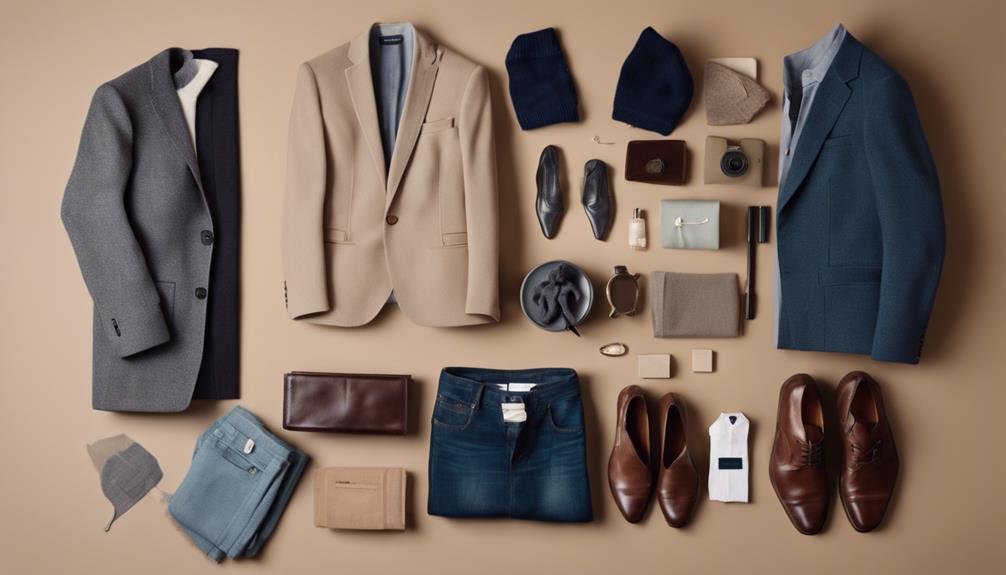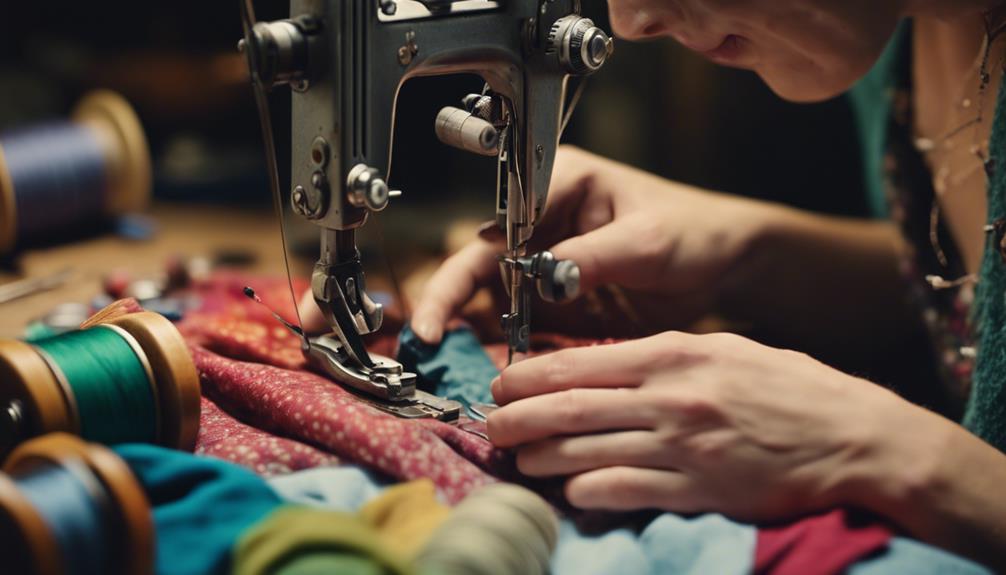You can have a significant impact on promoting sustainable fashion by taking small yet powerful steps. Begin by educating yourself on eco-friendly brands and investing in high-quality pieces that are durable. Embrace secondhand shopping to reduce waste and give clothing a second life. Practice proper clothing maintenance to extend the lifespan of your garments. When it’s time to let go of clothing, donate or recycle responsibly. Shift your shopping mentality by focusing on purposeful purchases and supporting ethical brands that resonate with your values. These suggestions can revolutionize your wardrobe—explore more ways to contribute to a more sustainable fashion future! Consider backing local and small businesses that prioritize sustainability and ethical standards. By choosing to shop from these establishments, you can support a more transparent and eco-friendly fashion industry. Also, think about organizing clothing swaps with friends and family as a fun and sustainable way to obtain new additions for your wardrobe. These sustainable fashion tips can help you reduce your environmental impact while still enjoying a chic and eco-conscious closet.
Key Takeaways
- Invest in high-quality wardrobe pieces that last longer, reducing the need for frequent replacements and promoting sustainability.
- Embrace secondhand shopping to divert textiles from landfills and support the circular economy.
- Prioritize ethical brands that use eco-friendly materials and uphold fair labor practices.
- Practice proper clothing care techniques, such as washing in cold water, to extend the life of garments.
Educate Yourself on Sustainability
To make informed choices in fashion, you need to educate yourself on sustainability and the impact your clothing has on the environment. The fashion industry is a significant contributor to pollution, with around 10% of global carbon emissions coming from clothing production. By understanding sustainable fashion, you can actively participate in reducing waste and making a positive environmental impact.
Start by researching brands that prioritize sustainability. It's vital to identify those that provide clear information about their eco-friendly practices. If you're unsure, don't hesitate to use social media to engage directly with these brands about their values. This communication fosters transparency and helps you make better choices when buying.
Also, explore resources and guides that showcase stylish sustainable brands. Contrary to popular belief, sustainable fashion can be both chic and luxurious. Staying informed about ongoing innovations—like recycled materials and ethical manufacturing—will empower you to make educated purchasing decisions.
Invest in Quality Wardrobe Pieces

When you invest in quality wardrobe pieces, you're not just buying clothes; you're making a choice for sustainability.
By prioritizing timeless styles and choosing durable materials, you can create a versatile wardrobe that lasts.
This approach not only reduces waste but also saves you money in the long run.
Prioritize Timeless Styles
Investing in timeless styles means choosing high-quality wardrobe pieces that serve you well across seasons, ultimately reducing waste and saving money.
By focusing on classic silhouettes and neutral colors, you can create a versatile wardrobe that allows you to mix and match effortlessly. This approach helps you extend the lifespan of your clothing, as timeless pieces remain fashionable and relevant year after year.
When you prioritize timeless styles, you're not just making a fashion statement; you're also contributing positively to the environment. High-quality garments typically last much longer than fast fashion items, meaning you'll buy less and reduce the environmental impact associated with frequent clothing production and disposal.
Research shows that well-made clothing can endure for a decade or more with proper care, making them a worthwhile investment.
Ultimately, adopting timeless styles leads to significant cost savings over time. By spending less on frequent replacements, you can recoup your initial investment and enjoy a more sustainable personal style.
Choose Durable Materials
Choosing durable materials is key to building a sustainable wardrobe that lasts and saves you money over time. By investing in high-quality clothing made from materials like organic cotton, wool, or Tencel, you not only enhance your style but also contribute to reducing waste. Durable items withstand wear and tear better than fast fashion alternatives, meaning you won't need to replace them as often.
Here are some tips for choosing durable materials:
- Opt for organic cotton: It's grown without harmful pesticides, making it a better option for the environment.
- Select well-constructed pieces: Look for items like sturdy jeans or classic coats that can endure daily wear.
- Prioritize timeless styles: Choose versatile pieces that can be styled in various ways, reducing the need for excessive purchases.
- Research brands: Support those that prioritize sustainable materials and ethical manufacturing practices.
Embrace Secondhand Shopping

Embracing secondhand shopping not only helps you save money but also reduces waste and supports a more sustainable fashion system.
You'll discover unique pieces that reflect your personal style while contributing to a circular economy.
Environmental Benefits of Secondhand
Shopping secondhand not only helps you discover unique styles but also plays an essential role in reducing waste and conserving valuable resources. By choosing to shop at secondhand stores, you actively lower your carbon footprint and improve your overall environmental footprint.
Here are some impressive benefits of embracing secondhand shopping:
- Waste Reduction: Purchasing used clothing diverts approximately 11.3 million tons of textiles from landfills in the U.S. each year.
- Water Conservation: You can save up to 70% of the water typically used in producing new clothing with every secondhand item you buy.
- Lower Emissions: Each secondhand purchase can prevent the emission of around 1,000 kilograms of carbon dioxide, helping combat climate change.
- Supporting the Circular Economy: Shopping secondhand promotes a sustainable lifecycle for clothing and reduces the demand for new, resource-intensive production.
Unique Finds and Savings
Discovering unique finds at thrift stores not only enhances your wardrobe but also offers considerable savings compared to traditional retail prices. When you embrace secondhand shopping, you can save 50-70% on clothing costs, making it a budget-friendly alternative. Plus, these shops often have one-of-a-kind pieces that you won't find in mainstream stores, allowing you to express your individual style creatively.
By opting for secondhand items, you're also contributing to a more sustainable future. Each piece you purchase helps reduce the demand for new clothing production, which considerably lowers the fashion industry's carbon footprint. Did you know that about 92 million tons of textile waste are generated annually? Supporting the circular economy through secondhand shopping aids in minimizing this waste.
Moreover, many thrift shops and online marketplaces give back to charitable causes with a portion of their proceeds. So, while you're enjoying the thrill of the hunt for unique finds, you're also making a positive impact in your community. Embrace secondhand shopping today, and enjoy the dual benefits of saving money while supporting sustainable fashion.
Practice Proper Clothing Care

Practicing proper clothing care can greatly extend the life of your garments and reduce waste. By properly maintaining your clothes, you not only save money but also minimize your environmental impact.
Here are some simple tips to help you keep your wardrobe in top shape:
- Wash clothes in cold water to save energy and minimize wear on fabrics.
- Follow care instructions specific to each fabric type to preserve their appearance and functionality.
- Utilize tools like steamers and fabric shavers to maintain garment condition and prevent the need for replacements.
- Engage in clothing repair techniques, such as sewing on buttons or mending small tears, to prolong the lifespan of your items.
Donate and Recycle Responsibly

Donating and recycling your unwanted clothes not only helps others but also plays an essential role in reducing waste and promoting sustainability. By participating in these practices, you can guarantee that your clothing has a second life while also supporting local communities. Remember, about 70% of donated clothing is reused or recycled, which considerably reduces landfill waste.
Here's a quick look at the impact of your clothing choices:
| Action | Impact |
|---|---|
| Donate | Supports charities and community programs |
| Recycle | Prevents 1.3 billion pounds of waste annually |
| One-in, One-out | Encourages sustainable wardrobe management |
| Tax Deductions | Financial benefits from donating clothing |
| Local Centers | Enhances community sustainability efforts |
Educate yourself about local recycling and donation options to maximize the effectiveness of your contributions. Implementing a one-in, one-out policy helps maintain a sustainable wardrobe while guaranteeing your unwanted clothing finds a new home. Every small action you take can have a lasting impact on sustainability, so start donating and recycling responsibly today!
Shift Your Shopping Mindset

Shifting your shopping mindset starts with recognizing the emotional triggers behind your purchases to distinguish between what you need and what you want. By taking a moment to reflect, you can avoid wasteful spending and potential regret.
Here are some tips to help you along the way:
- Embrace secondhand shopping: It's not only budget-friendly, but it also supports the circular economy.
- Invest in high-quality pieces: Choose timeless items that last longer, reducing the need for frequent replacements.
- Practice the one-in, one-out policy: For every new item you buy, let go of an old one to maintain balance and prevent overconsumption.
- Double-check your shopping cart: Before finalizing your purchase, verify that each item aligns with your long-term wardrobe goals and sustainability values.
Prioritize Ethical Brands

Recognizing the significance of conscious consumerism naturally leads you to prioritize ethical brands that champion fair labor practices and sustainable materials. By choosing these brands, you support fair wages and safe working conditions for workers, which is essential in an industry often marked by exploitation.
Many ethical brands utilize eco-friendly materials like organic cotton or recycled fabrics, greatly reducing their environmental impact compared to fast fashion. When you opt for these sustainable options, you're contributing to a healthier planet while enjoying high-quality products.
Look for certifications such as Fair Trade, Global Organic Textile Standard (GOTS), and B Corporation status to identify brands that adhere to rigorous social and environmental standards. These indicators assure you that the brand values ethical practices as much as you do.
As the demand for sustainable fashion grows, it's encouraging to see that 66% of global consumers are willing to pay more for ethical brands. Your choices matter, and by prioritizing these brands, you drive positive change within the fashion industry, helping to create a more sustainable and equitable future for all.
Explore Repair and Alteration Options

Exploring repair and alteration options not only extends the life of your clothing but also fosters a more sustainable relationship with your wardrobe.
By investing time in repairing and altering clothing, you can create pieces that will last much longer, reducing your reliance on fast fashion. Plus, it can save you money in the long run.
Here are some tips to get started:
- Learn basic mending skills: Simple techniques like sewing buttons or fixing hems can be done at home.
- Consider professional tailoring: A skilled tailor can transform ill-fitting items into stylish pieces that you'll love wearing.
- Use tailoring apps: Services like Sojo make it easy to access repair options, helping you embrace mending over discarding.
- Host a repair party: Gather friends to share skills and work on your clothing together, fostering community and creativity.
Frequently Asked Questions
How to Contribute to Sustainable Fashion?
You can contribute to sustainable fashion by choosing high-quality, timeless pieces, shopping secondhand, prioritizing eco-friendly brands, adopting a one-in, one-out policy for your wardrobe, and learning proper clothing care to extend garment life.
How Can Consumers Support Sustainable Fashion?
You can support sustainable fashion by choosing ethical brands, buying secondhand, participating in swaps, investing in quality pieces, and caring for your garments. Each action helps reduce waste and promotes a more sustainable industry.
How Can We Make Sustainable Fashion More Accessible?
To make sustainable fashion more accessible, you can promote local brands, support collaborations between retailers and eco-friendly companies, and explore subscription services or online platforms for secondhand clothing. These actions help broaden your sustainable wardrobe options.
How Can We Take Action to Encourage Sustainable Fashion Choices?
Did you know that the fashion industry produces over 92 million tons of waste annually? You can encourage sustainable fashion choices by opting for quality pieces, shopping secondhand, and supporting ethical brands committed to reducing environmental impact.
Conclusion
By embracing sustainable fashion, you're not just changing your wardrobe; you're weaving a brighter future.
Picture yourself in a cozy, well-loved sweater that tells a story, or striding confidently in a pair of ethically-made shoes.
Each choice you make ripples out, inspiring others to join the movement.
So, let's fill our closets with intention, cherish what we own, and support brands that care.
Together, we can transform the landscape of fashion into something beautiful and sustainable.









